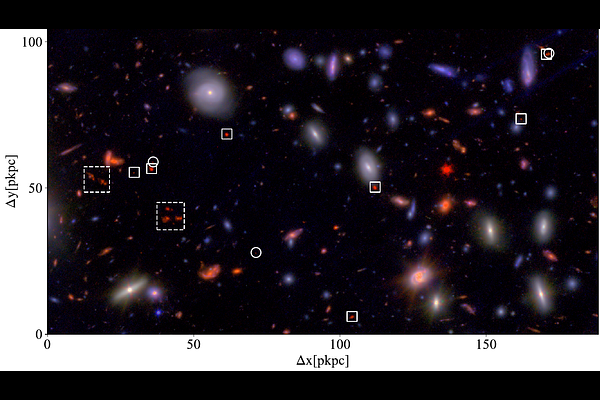Before its time: a remarkably evolved protocluster core at z=7.88

Before its time: a remarkably evolved protocluster core at z=7.88
Callum Witten, Pascal A. Oesch, William McClymont, Romain A. Meyer, Yoshinobu Fudamoto, Debora Sijacki, Nicolas Laporte, Jake S. Bennett, Charlotte Simmonds, Emma Giovinazzo, A. Lola Danhaive, Laure Ciesla, Cristian Carvajal-Bohorquez, Maxime Trebitsch
AbstractProtoclusters represent the most extreme environments in the very early Universe. They form from large-scale dark matter overdensities, harbouring an overabundance of galaxies fed by large gas reservoirs. Their early and accelerated evolution results in a distinct difference in the properties of galaxies resident in protoclusters versus the field, which is known to be in place by $z\sim 5-6$. We utilise JWST NIRCam observations of the A2744-z7p9OD protocluster at $z=7.88$ to constrain the properties of resident galaxies. We identify seven new protocluster members, bringing the total number to 23 and the total stellar mass of the protocluster to in excess of $10^{10}\ \rm{M_{\odot}}$. These galaxies are remarkably evolved just 650 Myr after the Big Bang, preferentially showing redder UV-slopes and stronger Balmer breaks than is typical of field galaxies. We use the PROSPECTOR spectral energy distribution fitting code to derive key galaxy properties, finding distinct populations in the core versus the outskirts of the protocluster. The core is largely composed of dusty, massive galaxies which can be characterised as undergoing a synchronised (mini)-quenched phase, while galaxies in the protocluster outskirts are undergoing recent bursts of star formation. Finally, a strong suppression of the continuum around the Ly$\alpha$-break evidences extreme neutral hydrogen column densities in many resident galaxies ($N_{\rm HI}\gtrsim10^{23}\ {\rm cm^{-2}}$). The A2744-z7p9OD system is the most extreme, evolved overdensity yet observed at $z>7$, with higher stellar masses, gas densities, and dust attenuation, revealing the intersection of local environment and high-redshift galaxy formation at their extremes.